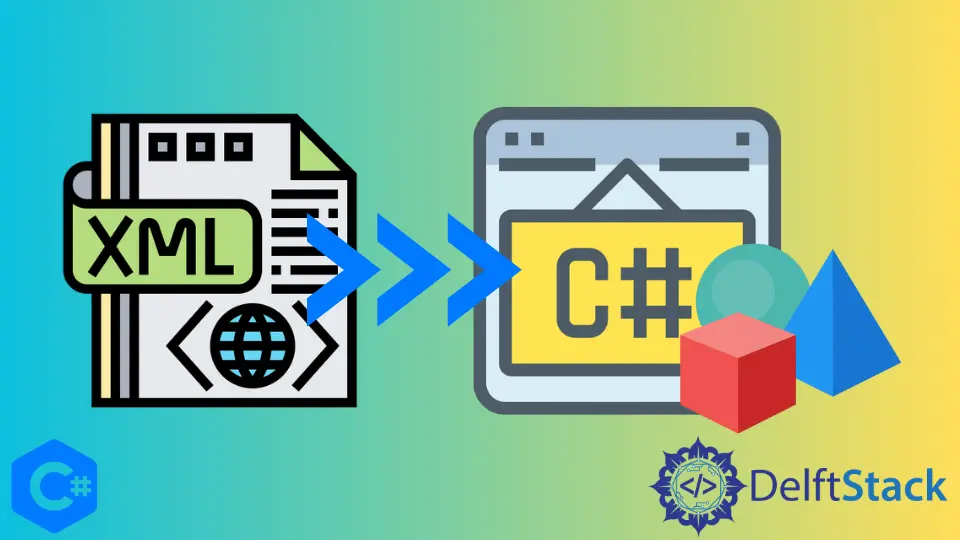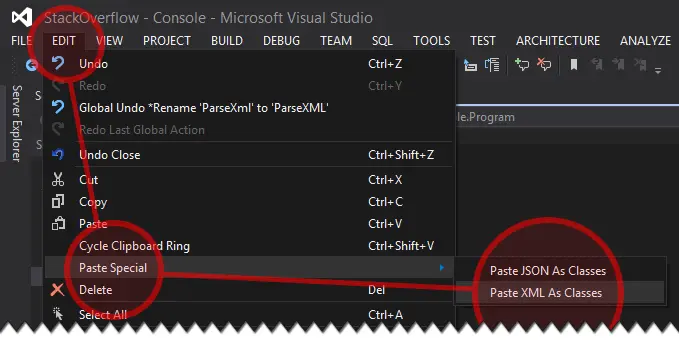在 C# 中將 XML 反序列化為物件
Abdullahi Salawudeen
2023年12月11日
Csharp
Csharp Object
- 使用手動型別的類將 XML 檔案反序列化為 C# 物件
-
使用 Visual Studio 的
Paste Special功能將Xml反序列化為 C# 物件 -
使用
XSD 工具將XML反序列化為 C# 物件

本文將演示將 XML 檔案轉換或反序列化為 C# 物件。
使用手動型別的類將 XML 檔案反序列化為 C# 物件
- C# 與
classes和objects以及attributes和methods相關聯。 Objects以程式設計方式用類表示,例如John或James。屬性是物件的特徵,例如汽車的顏色、生產年份、人的年齡或建築物的顏色。XML是允許解析XML資料而不考慮傳輸XML檔案的媒介的標準化格式。
進一步的討論可通過此參考網頁獲得。
下面是一個將轉換為 C# 物件的 XML 程式碼示例。
1. <?xml version="1.0" encoding="utf-8"?>
2. <Company xmlns:xsi="https://www.w3.org/2001/XMLSchema-instance" xmlns:xsd="https://www.w3.org/2001/XMLSchema">
3. <Employee name="x" age="30" />
4. <Employee name="y" age="32" />
5. </Company>
將在 C# 中建立具有類似結構的類來轉換 XML 程式碼示例。
using System.Xml.Serialization;
[XmlRoot(ElementName = "Company")]
public class Company
{
public Company() {
Employees = new List<Employee>();
}
[XmlElement(ElementName = "Employee")]
public List<Employee> Employees { get; set; }
public Employee this[string name] {
get {
return Employees.FirstOrDefault(
s => string.Equals(s.Name, name, StringComparison.OrdinalIgnoreCase));
}
}
}
public class Employee {
[XmlAttribute("name")]
public string Name { get; set; }
[XmlAttribute("age")]
public string Age { get; set; }
}
將 XML 物件轉換為 C# 的最後一步是使用 System.Xml.Serialization.XmlSerializer 函式來序列化物件。
public T DeserializeToObject<T>(string filepath)
where T : class {
System.Xml.Serialization.XmlSerializer ser =
new System.Xml.Serialization.XmlSerializer(typeof(T));
using (StreamReader sr = new StreamReader(filepath)) {
return (T)ser.Deserialize(sr);
}
}
使用 Visual Studio 的 Paste Special 功能將 Xml 反序列化為 C# 物件
此方法需要使用 Microsoft Visual Studio 2012 及更高版本和 .Net Framework 4.5 及更高版本。還必須安裝 Visual Studio 的 WCF 工作負載。
XML文件的內容必須複製到剪貼簿。- 在專案解決方案中新增一個新的
empty類。 - 開啟新的類檔案。
- 單擊 IDE 選單欄上的
Edit按鈕。 - 從下拉選單中選擇
Paste Special。 - 單擊
Paste XML As Classes。

要使用 Visual Studio 生成的類,請建立 Helpers 類。
using System;
using System.IO;
using System.Web.Script.Serialization; // Add reference: System.Web.Extensions
using System.Xml;
using System.Xml.Serialization;
namespace Helpers {
internal static class ParseHelpers
{
private static JavaScriptSerializer json;
private static JavaScriptSerializer JSON {
get { return json ?? (json = new JavaScriptSerializer()); }
}
public static Stream ToStream(this string @this) {
var stream = new MemoryStream();
var writer = new StreamWriter(stream);
writer.Write(@this);
writer.Flush();
stream.Position = 0;
return stream;
}
public static T ParseXML<T>(this string @this)
where T : class {
var reader = XmlReader.Create(
@this.Trim().ToStream(),
new XmlReaderSettings() { ConformanceLevel = ConformanceLevel.Document });
return new XmlSerializer(typeof(T)).Deserialize(reader) as T;
}
public static T ParseJSON<T>(this string @this)
where T : class {
return JSON.Deserialize<T>(@this.Trim());
}
}
}
使用 XSD 工具 將 XML 反序列化為 C# 物件
XSD 用於自動生成與 XML 檔案或文件中定義的模式等效的 classes 或 objects。
XSD.exe 通常在以下路徑中找到:C:\Program Files (x86)\Microsoft SDKs\Windows\{version}\bin\NETFX {version} Tools\。進一步的討論可以通過這個參考獲得。
假設 XML 檔案儲存在此路徑中:C:\X\test.XML。
以下是將 XML 自動反序列化為 C# 類的步驟:
- 在搜尋欄中鍵入
開發人員命令提示符並單擊它以開啟。 - 鍵入
cd C:\X導航到XML檔案路徑。 - 刪除
XML檔案中的行號和任何不必要的字元。 - 鍵入
xsd test.XML從 test.XML 建立一個等效的XSD 檔案。 - 在同一檔案路徑中建立一個
test.XSD檔案。 - 鍵入
XSD /c test.XSD建立與XML檔案等效的C# classes。 - 建立一個
test.cs檔案,一個具有XML檔案的精確模式的 C# 類。
輸出:
//------------------------------------------------------------------------------
// <auto-generated>
// This code was generated by a tool.
// Runtime Version:4.0.30319.42000
//
// Changes to this file may cause incorrect behavior and will be lost if
// the code is regenerated.
// </auto-generated>
//------------------------------------------------------------------------------
using System.Xml.Serialization;
//
// This source code was auto-generated by xsd, Version=4.8.3928.0.
//
/// <remarks/>
[System.CodeDom.Compiler.GeneratedCodeAttribute("xsd", "4.8.3928.0")]
[System.SerializableAttribute()]
[System.Diagnostics.DebuggerStepThroughAttribute()]
[System.ComponentModel.DesignerCategoryAttribute("code")]
[System.Xml.Serialization.XmlTypeAttribute(AnonymousType=true)]
[System.Xml.Serialization.XmlRootAttribute(Namespace="", IsNullable=false)]
public partial class Company {
private CompanyEmployee[] itemsField;
/// <remarks/>
[System.Xml.Serialization.XmlElementAttribute("Employee", Form=System.Xml.Schema.XmlSchemaForm.Unqualified)]
public CompanyEmployee[] Items {
get {
return this.itemsField;
}
set {
this.itemsField = value;
}
}
}
/// <remarks/>
[System.CodeDom.Compiler.GeneratedCodeAttribute("xsd", "4.8.3928.0")]
[System.SerializableAttribute()]
[System.Diagnostics.DebuggerStepThroughAttribute()]
[System.ComponentModel.DesignerCategoryAttribute("code")]
[System.Xml.Serialization.XmlTypeAttribute(AnonymousType=true)]
public partial class CompanyEmployee {
private string nameField;
private string ageField;
/// <remarks/>
[System.Xml.Serialization.XmlAttributeAttribute()]
public string name {
get {
return this.nameField;
}
set {
this.nameField = value;
}
}
/// <remarks/>
[System.Xml.Serialization.XmlAttributeAttribute()]
public string age {
get {
return this.ageField;
}
set {
this.ageField = value;
}
}
}
Enjoying our tutorials? Subscribe to DelftStack on YouTube to support us in creating more high-quality video guides. Subscribe
